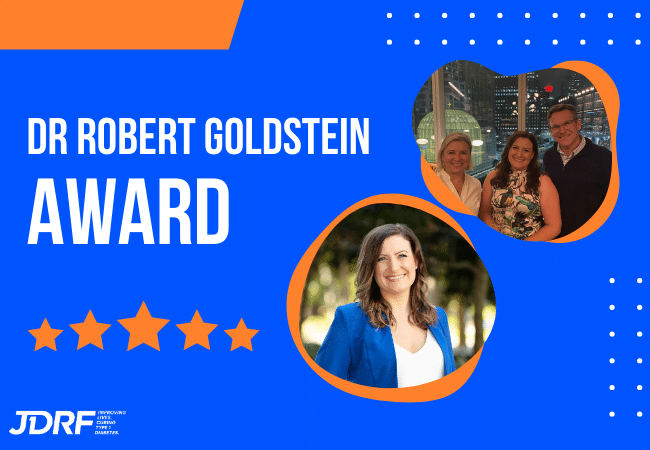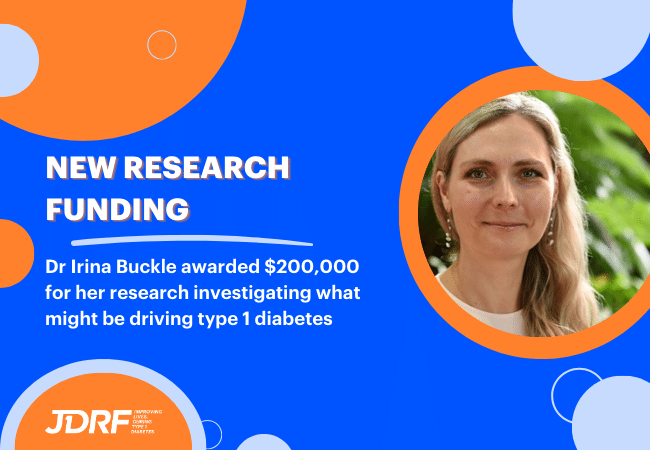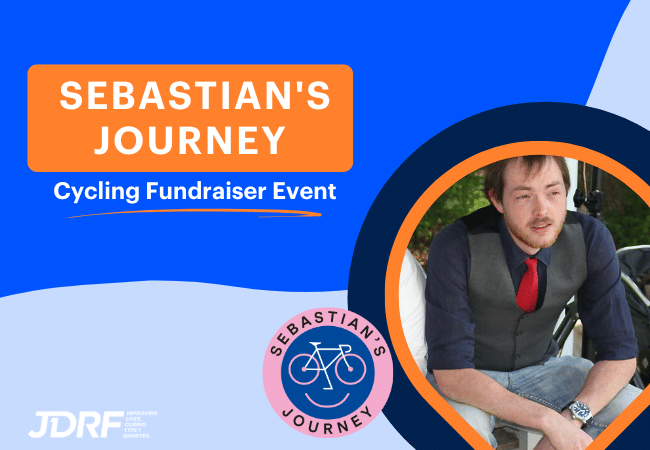Spotlight on Future Research Leader, Dr Kirstine Bell
Dr Kirstine Bell, better known to some as Kirstie
learnt a lot from the type 1 diabetes (T1D) community about what it’s like to live with the condition while she worked as a dietitian and credentialled diabetes educator (CDE).
Hearing from her patients got Dr Bell thinking, “there’s got to be a better way of doing things”. Her gut feeling led her to research how to improve insulin dosing for meals, with the aim of making life with T1D easier and safer. She’s now not only involved in this area, but also working on some other exciting research exploring a fibre supplement’s potential effect on T1D.
Not only is Dr Bell one of our very first JDRF/Macquarie Group Foundation Future Leaders but she was recently awarded a JDRF Travel Grant to present her ground-breaking research and share ideas at the American Diabetes Association Scientific Sessions 2018 conference.
Dr Bell has also completed post-doctoral research at, arguably the most famous educational institution in the world, Harvard Medical School. She’s already a powerhouse in the type 1 diabetes research arena, and her star is only going to rise.
Learn more about Dr Kirstie Bell, below:
1. Tell us about your research in T1D and how you came to be involved in the field
My passion for T1D began as an accredited practicing dietitian and CDE. Working closely with people with T1D, I realised that using carbohydrates only to calculate insulin doses can still make it difficult to keep blood sugars in range. This led me to research, which has validated what my patients were telling me. My research revealed that fat and protein also have significant impacts on blood glucose levels and insulin requirements. My current work is therefore focusing on understanding the optimal insulin adjustments needed for meals containing protein and/or fat. We are already in the process of creating an evidence-based insulin dose calculator for carbs, fat and protein, integrated into a smartphone app. The last thing we want to do is make life with T1D more difficult, however, so this app will include a food database that allows users to simply select their meals and it will automatically calculate the nutrient content and ideal insulin dose.
2. Tell us more about the new clinical trial you’ll be involved in
This is a very exciting new trial and we are very grateful to JDRF for entrusting us with it. We are trialling a new, specialised fibre that, one of our investigators, Dr Eliana Marino, has previously shown can prevent 90% of cases of T1D in mice. We think it works by influencing the gut bacteria which, in turn, turns off the autoimmune attack on the pancreas. Although we are still in the early stages of trialling this fibre in humans, it’s amazing to think that T1D could possibly be prevented with something as simple as a fibre supplement.
My role on the project is as a Principal Investigator for the Charles Perkins Centre site, meaning I am responsible for running the clinical trial from our dedicated clinical research centre at the University of Sydney. In this initial study, people with T1D will take the fibre supplement for six weeks, with a follow-up appointment after 12 weeks. I’ll be responsible for everything directly relating to our study participants, from recruitment to seeing them at all their study appointments, giving out the fibre supplement and collecting their clinical measures. I’ll then pass these samples on to the other investigators also leading this trial, who will analyse them in their laboratories across Australia.
3. What are the next steps for this research?
If this study proves successful, the next step will be a bigger clinical trial, recruiting people newly diagnosed with T1D, to see if the fibre supplement can help prolong their ‘honeymoon phase’, where the beta-cells in the pancreas are still producing some insulin. The longer we can make this honeymoon phase last, the less insulin they will need to take and the more protected they will be from long-term complications. The final stage of the research, will be an even bigger trial to see if we can prevent, or at least delay the onset of T1D, in those who are at high risk of the disease.
4. It’s been over a year since you became involved in the Future Research Leaders Program, what are some useful things you learned as part of the Program and how has this influenced your career?
The JDRF/Macquarie Group Foundation Future Leaders Program has been incredibly beneficial. In this time, I have finished my first clinical trial as the Principal Investigator and, with JDRF’s support, presented the results at the American Diabetes Association Conference – the largest diabetes conference in the world.
The Program really highlighted to me the importance of thinking laterally and working with other research disciplines to come up with new, creative solutions for T1D. As a result, I have started new research collaborations both at University of Sydney and with other groups in Australia and internationally. I am also working to establish a new dedicated T1D project node at the Charles Perkins Centre to bring together all the T1D researchers to share expertise and spark new ideas and innovations.
Through the Program, I have also learnt a lot about what it means to be a good research leader. I have taken on five new research students since I began in the Program and have really tried to invest in these students, so they achieve their potential and can make valuable contributions to the T1D community too.




